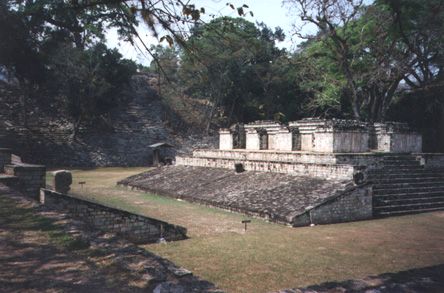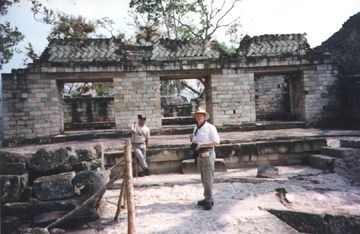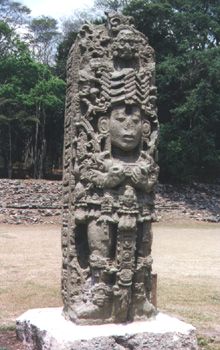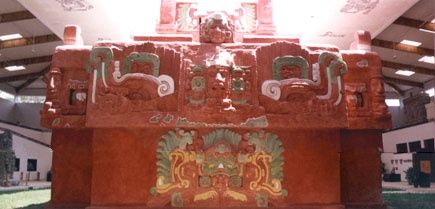06 APRIL (Sunday)
After a quick breakfast we drove out to the archeological site of Copan. We were one of
the first ones there, but it never got crowded during the day. We toured the little museum
at the admission booth, then set off down the path to the ruins. We entered the rain
forest, noting that this was a very dry area, and not the type of rain forest that you see
in the movies. At the entrance to the site we stopped to take pictures of some pet macaws,
and then met Oscar, who was one of the local guides offering his services. We accepted his
offer, and listened to a short history of Copan while he pointed out key areas on the
large mounted map. Then he took us off through the site, telling us about each area, and
waiting while we took our photos and video shots. (I manned the video camera for most of
the trip, while Sue took the stills, averaging two to three rolls per site. I also took
the occasional photo with a small 35mm panoramic camera that I had.) We found Oscar to be
very knowledgeable and friendly, and were glad to have hired his services.

The ballcourt at Copan. Note how dry the grass is, unlike the vibrant greens you see in
the postcards. This is because April is at the end of the dry season, so we're at the
driest point of the year. The two signs at each end of the ballcourt say to keep off the
grass of the playing field. Unbeknownst to the majority of visitors who walk in this
plaza, there is actually the original plaster floor of the entire courtyard still buried
beneath their feet, under several inches of sod.

Here I'm standing in front of one of the Copan temple buildings currently under
reconstruction. The stones in the roof facade emulate the woven pattern of a Mayan rug.
This building has had major repairs, and has probably been completed by now. I'm in the
foreground (with camcorder in hand and guidebook in pocket, while our local guide Oscar
waits farther back.

One of the tall (8-12 feet) stelae that Copan is famous for. A stelae is a combination
of a statue and a ceremonial marker, with Mayan glyphs (writing) covering both sides and
back. The stelae at Copan were unique in that the images of the kings were presented in a
more three dimensional format, unlike the more common flat stelae found at other sites. I
bought a 10 inch high replica in stone of a similar stelae as a souvenir.
By mid-day we had completed the tour, and we went back towards the admission booth
where we had lunch at a little eatery that was there. This became a pattern for us:
explore until mid-day, then when the heat was at its worst we would take time for a
relaxing lunch, returning to the site in the afternoon. The number of people at the site
definitely declined in the afternoon hours (not that there were that many to begin with).
We went back to re-visit different parts of the site, and eventually came to feel that we
had seen most all of what there was to see. We again left the ruins and headed towards the
car, but we stopped to check out a building that we had previously been ignoring. Not too
far from the eatery was a large building that I had at first thought to be a school,
archeological institute, or some other official building. It was obviously brand-new, and
was not mentioned in any of our guide books. When you got close to it on the path, you
could see that the hill that it rested upon had a underground entrance to it. This opening
was made of stone, and was carved to resemble the mouth of a Mayan god, complete with
curved teeth. You entered into the "mouth" of the cave, and proceeded through a
subterranean tunnel representing a trip through the Mayan underworld. After a short while
and a bend in the tunnel you suddenly emerged into the bright light of the inside of the
building. Sunlight streamed in through the open area of the ceiling, which illuminated
museum with a single large interior room that had two levels of pathways running around
its walls. In the center was the full-size replica of a Mayan temple, built to show it as
it would have appeared centuries ago, complete with all it's exterior carvings and bright
paint. We were not expecting this, and were stunned. None of our pictures would later do
it justice, and it was so big that we had trouble getting it to fit in a single frame. You
can't actually go in the temple, but you can view it from all four sides. Also inside this
new museum were numerous pieces of sculpture from Copan, including a number of original
pieces that were replaced at the site by replicas. In this way they could preserve the
more valuable pieces by getting them in out of the elements. This museum was modern, well
done, and well worth visiting. Don't pass it up if you go to Copan.

Sunlight comes through the open roof of the new Copan museum onto the life-size
replica of the Rosalila temple. It looks much more impressive in person than in the photo.
(Click here to check out the official website with more photos of
Rosalila.)
By now it was late afternoon, but not quite dinner time yet. We got back in the
Suburban and drove on down the road (only about 2 kilometers, I think), and stopped at the
site of Las Sepulturas. This is the residential area where the elite Mayans of Copan
actually lived (the ruins of Copan itself is more of a ceremonial center than a city). We
were the only ones there, except for one guard, who followed us around to keep an eye on
us, though mostly from a distance.
By the time we were done it was closing time anyway, so we headed back
to town, where we unloaded at the hotel and set off on foot to find a restaurant for
dinner. Our guide book information was somewhat out of date, as the first several
restaurants we looked for were closed or no longer there. On our journey through the city
streets we found a few more shops and a number of down-to-earth bars and eateries. We also
found ourselves walking through a residential section, complete with chickens, pigs, and
other farm animals all over the yards and in the street. We felt very out of place and
very much aware of the "third world" aspect of our surroundings, but we never
felt in danger, and we eventually found a nice looking restaurant, where we again found
ourselves to be the only patrons (I guess that since most of the tourists were Europeans,
they would be eating dinner at a later time than us). After dinner headed back to the
hotel, and I took the time to buy a small statue and a poster to remember our visit by.